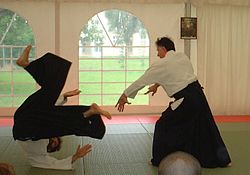- ↑ judoinfo.com
- ↑ Shite can also refer to the principal character in a Japanese Noh play
This page is based on this Wikipedia article
Text is available under the CC BY-SA 4.0 license; additional terms may apply.
Images, videos and audio are available under their respective licenses.
Text is available under the CC BY-SA 4.0 license; additional terms may apply.
Images, videos and audio are available under their respective licenses.
| Tori | |
|---|---|
 Tori, on right, executes a throw against uke , on left. |